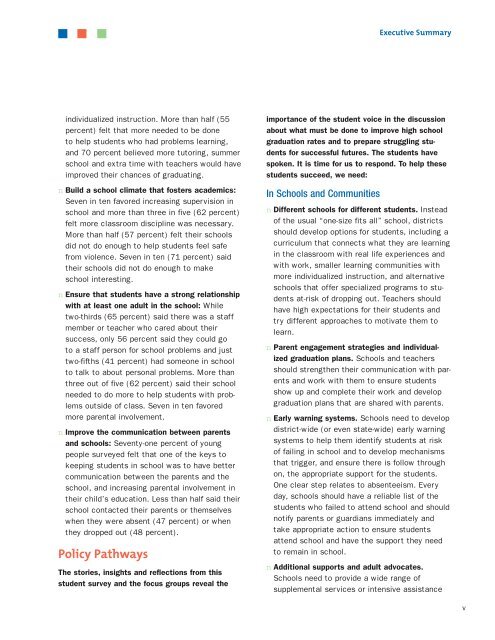The Silent Epidemic: Perspectives of High School ... - Ignite! Learning
The Silent Epidemic: Perspectives of High School ... - Ignite! Learning
The Silent Epidemic: Perspectives of High School ... - Ignite! Learning
You also want an ePaper? Increase the reach of your titles
YUMPU automatically turns print PDFs into web optimized ePapers that Google loves.
individualized instruction. More than half (55<br />
percent) felt that more needed to be done<br />
to help students who had problems learning,<br />
and 70 percent believed more tutoring, summer<br />
school and extra time with teachers would have<br />
improved their chances <strong>of</strong> graduating.<br />
n Build a school climate that fosters academics:<br />
Seven in ten favored increasing supervision in<br />
school and more than three in five (62 percent)<br />
felt more classroom discipline was necessary.<br />
More than half (57 percent) felt their schools<br />
did not do enough to help students feel safe<br />
from violence. Seven in ten (71 percent) said<br />
their schools did not do enough to make<br />
school interesting.<br />
n Ensure that students have a strong relationship<br />
with at least one adult in the school: While<br />
two-thirds (65 percent) said there was a staff<br />
member or teacher who cared about their<br />
success, only 56 percent said they could go<br />
to a staff person for school problems and just<br />
two-fifths (41 percent) had someone in school<br />
to talk to about personal problems. More than<br />
three out <strong>of</strong> five (62 percent) said their school<br />
needed to do more to help students with problems<br />
outside <strong>of</strong> class. Seven in ten favored<br />
more parental involvement.<br />
n Improve the communication between parents<br />
and schools: Seventy-one percent <strong>of</strong> young<br />
people surveyed felt that one <strong>of</strong> the keys to<br />
keeping students in school was to have better<br />
communication between the parents and the<br />
school, and increasing parental involvement in<br />
their child’s education. Less than half said their<br />
school contacted their parents or themselves<br />
when they were absent (47 percent) or when<br />
they dropped out (48 percent).<br />
Policy Pathways<br />
<strong>The</strong> stories, insights and reflections from this<br />
student survey and the focus groups reveal the<br />
Executive Summary<br />
importance <strong>of</strong> the student voice in the discussion<br />
about what must be done to improve high school<br />
graduation rates and to prepare struggling students<br />
for successful futures. <strong>The</strong> students have<br />
spoken. It is time for us to respond. To help these<br />
students succeed, we need:<br />
In <strong>School</strong>s and Communities<br />
n Different schools for different students. Instead<br />
<strong>of</strong> the usual “one-size fits all” school, districts<br />
should develop options for students, including a<br />
curriculum that connects what they are learning<br />
in the classroom with real life experiences and<br />
with work, smaller learning communities with<br />
more individualized instruction, and alternative<br />
schools that <strong>of</strong>fer specialized programs to students<br />
at-risk <strong>of</strong> dropping out. Teachers should<br />
have high expectations for their students and<br />
try different approaches to motivate them to<br />
learn.<br />
n Parent engagement strategies and individualized<br />
graduation plans. <strong>School</strong>s and teachers<br />
should strengthen their communication with parents<br />
and work with them to ensure students<br />
show up and complete their work and develop<br />
graduation plans that are shared with parents.<br />
n Early warning systems. <strong>School</strong>s need to develop<br />
district-wide (or even state-wide) early warning<br />
systems to help them identify students at risk<br />
<strong>of</strong> failing in school and to develop mechanisms<br />
that trigger, and ensure there is follow through<br />
on, the appropriate support for the students.<br />
One clear step relates to absenteeism. Every<br />
day, schools should have a reliable list <strong>of</strong> the<br />
students who failed to attend school and should<br />
notify parents or guardians immediately and<br />
take appropriate action to ensure students<br />
attend school and have the support they need<br />
to remain in school.<br />
n Additional supports and adult advocates.<br />
<strong>School</strong>s need to provide a wide range <strong>of</strong><br />
supplemental services or intensive assistance<br />
v








